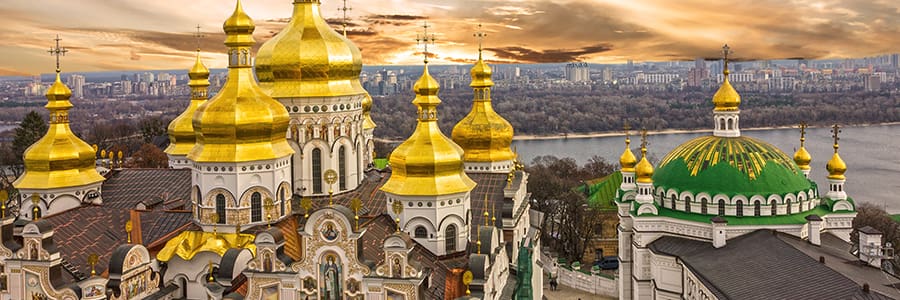
About The Dnieper River
It’s pronounced: Nee-per
Rising in the north of beautiful Ukraine, and flowing south through Ukraine to the Black Sea, the Dnieper is one of the major rivers of Europe. In antiquity, the river was known to the Greeks as the Borysthenes, and was part of the Amber Road, the ancient trade route from the North and Baltic Seas to the Mediterranean.
The second-largest country in Eastern Europe, Ukraine remains shrouded in mystery to most Westerners, and cruising the Dnieper offers an excellent way to experience both its beauty and its long and turbulent history. Highlights include Odessa, “The Pearl of the Black Sea,” with its classical buildings and boulevards, historic Yalta, the Cossacks of Zaporozhye, and Kiev, one of Europe’s most dynamic capitals, filled with theaters, museums, ancient ruins, religious sites, and vibrant modern art and architecture.
With the treasures of the Ukraine so far off the beaten track, cruising is the sensible way to go. In addition to included shore excursions and onboard activities offering insight into the region’s history and culture, river cruising allows optimal time for relaxing to take in the scenery or adventuring further to pursue private passions.
Dnieper River Stats
Length: 1,333 miles
Depth: average 26 feet
Source: Valdai Hills, Russia
Mouth: Dnieper Delta into the Black Sea, Ukraine
Locks: 5
Countries: Ukraine | Belarus | Russia
Learn More About the Dnieper River of Ukraine
The Dnieper River, known as Dnipro in Ukrainian, is one of Europe’s major rivers, flowing through Ukraine. With a length of approximately 2,200 kilometers, it is the third-longest river in Europe, after the Volga and the Danube. The Dnieper has played a vital role in the history, culture, and ecology of the region, making it a fascinating subject to explore.
Geography and Hydrology
The Dnieper River originates in the Valdai Hills and flows southward through Ukraine before emptying into the Black Sea. It is a river of great ecological significance, as it traverses various landscapes, from dense forests and wetlands in the north to open plains and fertile valleys in the south. Its basin covers approximately 504,000 square kilometers, making it one of Europe’s most significant drainage basins. The river’s hydrology is subject to seasonal variations, with spring and early summer being the peak flow periods due to melting snow and increased rainfall. During this time, the Dnieper can swell to impressive widths and carry significant sediment loads. In contrast, in late summer and autumn, the river’s flow decreases, revealing vast sandbanks and islands along its course.
Historical Significance
The Dnieper River has been a witness to and a participant in many crucial events throughout history. It has served as a natural barrier, a trade route, and a source of livelihood for countless generations.
Trade and Commerce
In ancient times, the Dnieper was a major trade route connecting the Baltic Sea to the Black Sea. The Vikings, known as the Varangians, used the river to establish trade routes between Northern Europe and the Byzantine Empire. This trade was essential in shaping the culture and economies of the regions along the riverbanks.
Medieval Cities
Several historic cities, including Kiev, the capital of Ukraine, are situated along the Dnieper. Kiev, in particular, has a rich history dating back over a thousand years. It was a center of trade, culture, and power during the Kievan Rus period and played a pivotal role in the spread of Christianity in Eastern Europe.
Conflict and Warfare
The Dnieper has also been a strategic battleground in various conflicts. During World War II, it marked the eastern front, with fierce battles taking place along its banks. Today, remnants of military fortifications and war memorials can still be found along the river.
Hydroelectric Power
In the 20th century, the Dnieper became a source of hydroelectric power generation. The construction of the Dnieper Hydroelectric Station in the 1930s created the largest artificial reservoir in Europe, the Dnieper Reservoir. This not only provides electricity but also regulates water flow and supports irrigation.
Ecological Diversity
The Dnieper River and its surrounding ecosystems are home to a wide variety of flora and fauna. The river’s upper reaches flow through pristine wilderness areas with dense forests and wetlands. These areas are vital for biodiversity, providing habitats for numerous species of birds, mammals, and fish. The Dnieper is also known for its fisheries. Historically, it supported vast populations of sturgeon, which were harvested for their valuable caviar. However, overfishing and habitat degradation have led to a decline in sturgeon populations. Conservation efforts are ongoing to protect these and other species.
Challenges and Environmental Concerns
Despite its ecological and historical significance, the Dnieper River faces numerous challenges today. Pollution from industrial discharges, agriculture runoff, and urban development has led to water quality issues. The river’s flow is also regulated by a series of dams and reservoirs, which can have adverse effects on downstream ecosystems and water levels. Efforts to address these issues include water quality monitoring, habitat restoration projects, and international cooperation among the countries through which the Dnieper flows. However, finding a balance between economic development and environmental preservation remains a complex challenge.
Recreation and Tourism
In recent years, the Dnieper River has gained popularity as a destination for river cruises and recreational activities. Travelers can explore the river’s historic cities, enjoy scenic landscapes, and experience the rich culture of the region. Water sports, fishing, and birdwatching are also popular activities along the river.
